
NPS Photo / Claire Abendroth
The National Park Service (NPS) defines non-native or exotic species as those occurring in a given place as a result of actions of humans. Compared to parks in the rest of the United States, the NPS units in Alaska are relatively clear of exotic plants. Most exotic plant species are confined to areas that have been disturbed by humans.
Several factors have protected Alaskan parks from the widespread invasion of exotic plants:
- Past and current climates: Past climates have produced a flora low in diversity but adapted to a wide range of ecological conditions. For example, many of Denali’s shrubs and herbs are circumpolar or circumboreal in distribution. They are adapted to thrive in the harsh subarctic conditions. Most exotic taxa are not adapted to the current climate of interior Alaska.
- Undisturbed ecosystems: For the most part, Alaskan parks’ ecosystems and processes have all the pieces. This includes key predators, herbivores, and a relatively natural wildfire regime. Ecosystems of parks in other states, by comparison, are altered by livestock grazing, wildfire suppression, altered hydrology, and other factors that ease the entry of exotic species.
- Big country: Most parks in Alaska are large enough to include all the ecosystem pieces, and are surrounded by undeveloped lands. In comparison, parks in other states are islands in a sea of altered ecosystems heavily influenced by highly invasive exotic plants
In spite of these protective factors, the threat to parks in Alaska from exotic plants is increasing and Denali is no exception. New exotic plants are appearing, and some of those already present are spreading. For example, white sweetclover (Melilotus alba) has invaded naturally open riparian areas elsewhere in Alaska, but is still confined to areas of human disturbance in Denali. Bird vetch (Vicia cracca) is also of concern. It can invade stands of shrubs and tree saplings by climbing and spreading over the native plants. Although bird vetch is not yet a widespread problem in Denali or other Alaskan parks, it is a threat in the urban-wildland interface of Alaska and many parks nationwide.
To ensure that Denali’s native vegetation remains pristine, park staff and volunteers work every summer to keep populations of non-native plants low and away from areas of established native vegetation. So while you may see ‘weeds’ along the Park Road, know that beyond the boundary of human disturbance lies millions of acres of native plant life.
Learn more about how Denali's Exotic Plant Management Team responds to invasions of non-native plants.
Several of the more concerning or widespread invaders are described below. Bird vetch (Vicia cracca), narrowleaf hawksbeard (Crepis tectorum), and white sweetclover (Melilotus alba) are known to be especially ruthless competitors with native floras, even in the subarctic. In fact, some of them have already had considerable impacts on native floras in other areas of the subarctic. It is important for park visitors and staff to be aware of these species and to be on the lookout for possible invasions.
Common Dandelion
(Taraxacum officinale)

NPS Photo
The exotic dandelion can grow 2–20 inches tall. Its basal leaves are 2–16 inches long and 0.5–4 inches wide. Flowers grow on hollow stocks from this basal rosette. The yellow flower heads are composed only of ray florets and are 1–2 inches wide.
Although not the most aggressive of invaders, the exotic dandelion is the most common invasive plant in Denali. Well-known from grass-lawns and disturbed areas throughout North America, in Denali the exotic dandelion is locally abundant along roadsides in the first 15 miles of the park road, and sporadic until Kantishna where they become common again. So far, the exotic dandelion has not shown any ability to invade native habitats away from disturbed areas along the road.
The exotic dandelion can reproduce via wind-born seeds (over 200 per pant, and over 5,000 per year) or vegetatively via shoots off of root crowns. The seeds remain viable in the soil for up to five years and can impact native successional processes. Plants can be pulled by hand, but like in your yard at home, you must use a digging tool to get the root crown and prevent resprouting. Control efforts are currently focused on keeping the investation from spreading beyond Savage River (Mile 15). With the help of volunteers, hundreds of pounds of dandelions are removed by digging each year.
The exotic dandelion is not the only dandelion present in Denali. Five species of native dandelion also prosper in the gravelly soils that the exotic dandelion is quick to colonize. Denali’s native dandelions (top photo) have shorter, narrower leaves clustered closer to the ground compared to the non-native dandelion (bottom photo). In addition, the bracts (leaf-like structures under the flower head) of native species cup the flowers, while the bracts point down on non-native species.
Narrowleaf Hawksbeard
(Crepis tectorum)
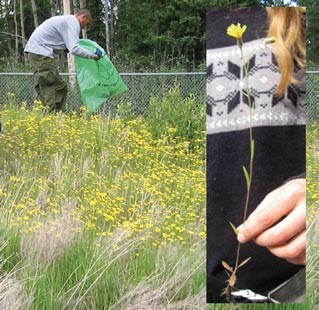
NPS Photo
Narrowleaf hawksbeard is a single-stemmed, upright plant with many narrow (<1/2 inch wide) leaves clasping the stem. It can reach up to 1 meter tall and grows from a deep taproot. Basal leaves are in a rosette, but stalked and lance-shaped, 4–6 inches long and 1.5 inches wide. The flower is 1/2–3/4 inches wide and made up of 30–70 ray florets.
Each plant is capable of producing over 50,000 seeds. The seeds are wind-dispersed and require no period of dormancy before germination, so they are able to readily colonize disturbed sites. When in seed, the seed head looks like a small dandelion.
Narrowleaf hawksbeard is pulled easily by hand. However, several visits are often necessary to eliminate plants overlooked when in their small rosette stage or not yet flowering. Utimate eradication is best achieved by using herbicides.
This plant was first documented in Alaska in 1974. In Denali, seeds of the narrowleaf hawksbeard were accidentally brought in with soil for a construction project in 2003, and an infestation grew that was combatted through years of intensive management. It remains prevalent along the Park Road near the Denali Bus Depot. New infestations are sometimes difficult to detect because the narrowleaf hawksbeard can be difficult to spot when not in flower and its dainty stem allows it to hide amongst native vegetation.
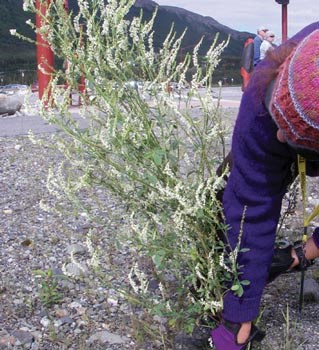
NPS Photo
White Sweetclover
(Melilotus alba)
White sweetclover is a biennial, often many-branched, plant capable of growing 2–5 feet (1.5 m) tall. The leaves are trifoliate, alternate on the stem, and 0.5–2 inches long. Flowers are fragrant, white, and 1/8–1/4 inches long.
Each plant is capable of producing up to 350,000 seeds and each seed can stay viable in the soil for over 80 years. These qualities allow it to readily invade open areas where seeds are dispersed by wind or water. White sweetclover does well in interior Alaska because it can withstand cold winters. It also benefits from wildfire, which scarifies (helps to break open) the seed coats and stimulates germination. Hand-pulling as a method of removal is effective, but many repeat treatments are necessary before the ample and long-lived seed banks are exhausted.
White sweetclover was brought to North America as early as 1664 for use as a forage crop. Since then, it has spread to all 50 of the United States. In Alaska, it has formed large populations along rivers throughout the state. It is also found along highways in Alaska—including the Parks Highway which runs by the main entrance to Denali National Park and Preserve. It is currently seen in small patches along the park road. Attractive to pollinators and able to shade out competitors, white sweetclover is likely to become even more of a problem with time.
Bird Vetch
(Vicia cracca)
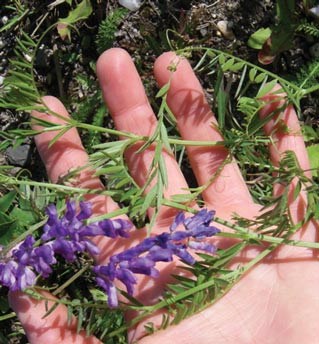
NPS Photo
Bird vetch is a climbing perennial plant with weak stems. It gains height by clinging to other plants with coiling tendrils at the end of each leaf. Leaves are made up of 8–10 pairs of narrow leaflets in a row. Flowers are bluish-violet and are situated on the stalk to all face one direction. Bird vetch can be mistaken for a common native plant, alpine sweetvetch (Hedysarum alpinum) whose roots are an important source of food for grizzly bears. Unlike alpine sweetvetch, bird vetch has a sinister curled tendril at the end of each stalk which clings to native vegetation and helps it choke and shade out its nearby competitors.
Bird vetch spreads rapidly, and is able to reproduce vegetatively through spreading rhizomes. It is highly tolerant of fire, drought, and interior Alaska's long and cold winters. Many seeds are produced and seeds remain viable for approximately 5 years in the soil. Bird vetch is also particularly attractive to native bees and thus has the potential to alter pollination ecology. Hand-pulling can be an effective way to battle small infestations of bird vetch, but this method often requires retreatment. Herbicide is necessary for complete control.
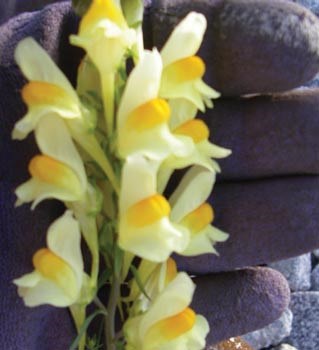
NPS Photo
The dreaded bird vetch was planted in Fairbanks, Alaska in the 1950s as an experimental forage crop for livestock. Since then, it has unfortunately become common throughout the Fairbanks area, choking many native species out of their preferred habitats. With high rates of travel between Fairbanks and other Alaskan cities, bird vetch is now a problem throughout many areas of the state, including Denali. In the park, it has been found in six small infestations along the paved portion of the park road.
Yellow Toadflax
(Linaria vulgaris)
Yellow toadflax has a yellow and orange snapdragon-like flower with 1,500 to 30,000 seeds per plant. The plant sends a hefty taproot nearly 3 feet (1 meter) into the soil, pulling up moisture and nutrients more efficiently than native plants. In Denali, this ornamental arrived from Anchorage and is found at the railroad tracks.
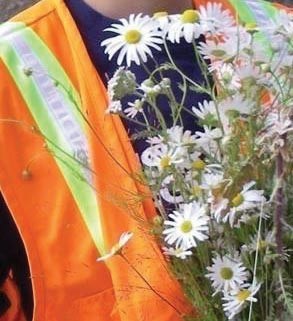
NPS Photo
Scentless False Mayweed
(Tripleurospermum perforata)
This is the only plant in Denali with daisy-like flowers. Leaves are 3/4 to 3 inches long with narrow, branching, thread-like segments. Mayweed has an extensive root system that can reduce available moisture for native plants and a single plant can produce over 300,000 seeds. In Denali, mayweed is found only at the railroad tracks.
Other Invasive Species
Although 28 invasive species have been documented in Denali, only 15 are considered current threats. These 15 species (the six described above and nine listed below) are mapped, monitored, and removed to the maximum extent possible each year.
- Foxtail barley (Taraxcum officinale)
- Common plantain (Plantago major)
- Alsike, red, and white clover (Trifolium spp.)
- Lambsquarters (Chenopodium album)
- Narrowleaf Hawksleaf (Hieracium umbellatum)
- Pineappleweed (Matricaria discoidea)
- Splitip hempnettle (Galeopsis bifida)
- Yellow sweetclover (Melilotus officinalis)
- Night-flowering silene (Silene noctiflora)
More Information
Last updated: November 7, 2023
